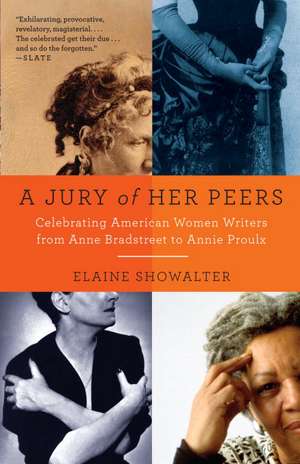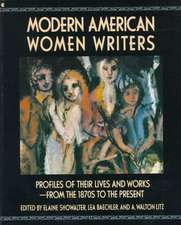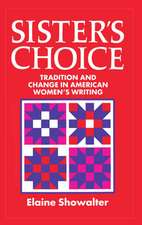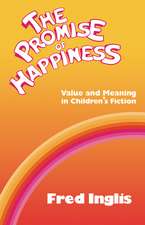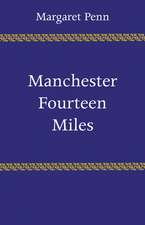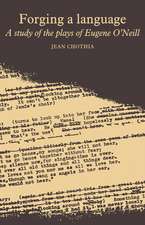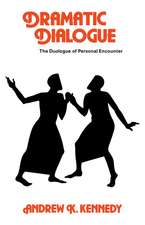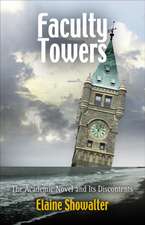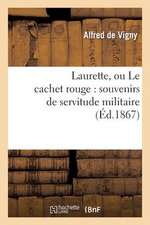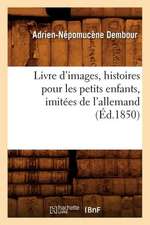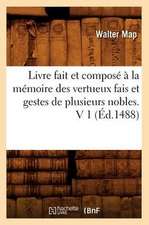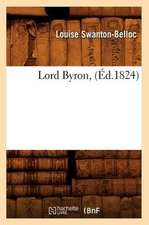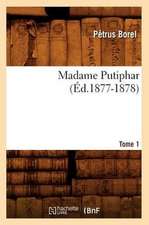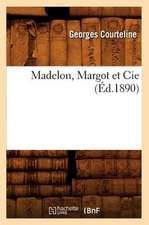A Jury of Her Peers: American Women Writers from Anne Bradstreet to Annie Proulx
Autor Elaine Showalteren Limba Engleză Paperback – 31 dec 2009
In a narrative of immense scope and fascination, here are more than 250 female writers, including the famous—Harriet Beecher Stowe, Dorothy Parker, Flannery O’Connor, and Toni Morrison, among others—and the little known, from the early American bestselling novelist Catherine Sedgwick to the Pulitzer Prize-winning playwright Susan Glaspell. Showalter integrates women’s contributions into our nation’s literary heritage with brilliance and flair, making the case for the unfairly overlooked and putting the overrated firmly in their place.
Preț: 137.90 lei
Nou
Puncte Express: 207
Preț estimativ în valută:
26.39€ • 27.62$ • 21.83£
26.39€ • 27.62$ • 21.83£
Carte disponibilă
Livrare economică 17-31 martie
Preluare comenzi: 021 569.72.76
Specificații
ISBN-13: 9781400034420
ISBN-10: 1400034426
Pagini: 586
Dimensiuni: 154 x 235 x 28 mm
Greutate: 0.59 kg
Editura: Vintage Books USA
ISBN-10: 1400034426
Pagini: 586
Dimensiuni: 154 x 235 x 28 mm
Greutate: 0.59 kg
Editura: Vintage Books USA
Notă biografică
Elaine Showalter, a professor emerita at Princeton University, is the author of numerous books, including the groundbreaking A Literature of Their Own: British Women Novelists from Brontë to Lessing. A frequent radio and TV commentator in the United Kingdom, she has chaired the Man Booker International prize jury and judged the National Book Awards and the Orange Prize. She divides her time between Washington, D.C., and London.
From the Hardcover edition.
From the Hardcover edition.
Extras
I
A New Literature Springs Up in the New World
From the very beginning, women were creating the new words of the New World. The first women writers in America, Anne Bradstreet (1612–1672) and Mary Rowlandson (1637–1711), were born in England and endured the harrowing three-month voyage of storm, seasickness, and starvation across the North Atlantic. In Massachusetts, where they settled, they led lives of extraordinary danger and deprivation. Both married and had children; they thought of themselves primarily as good wives and mothers. Both made the glory of God their justification for writing, but they prefigured themes and concerns that would preoccupy American women writers for the next 150 years and more—Bradstreet, the poet, writing about the intimacies and agonies of domestic life, including pregnancy and maternity, the death of three of her grandchildren, and the destruction of her home by fire; and Rowlandson, writing a narrative of her captivity by Narragansett Indians, and pioneering the great American theme of interracial experience in the encounter with Native American culture.
Both Bradstreet and Rowlandson entered print shielded by the authorization, legitimization, and testimony of men. In Bradstreet’s case, no fewer than eleven men wrote testimonials and poems praising her piety and industry, prefatory materials almost as long as the thirteen poems in the book. In his introductory letter, John Woodbridge, her brother-in-law, stood guarantee that Bradstreet herself had written the poems, that she had not initiated their publication, and that she had neglected no housekeeping chore in their making: “these Poems are the fruit but of some few houres, curtailed from her sleep and other refreshments.” Rowlandson’s narrative too came with “a preface to the reader” signed “Per Amicum” (“By a Friend”), probably the minister Increase Mather, which explained that although the work had been “penned by this Gentlewoman,” she had written it as a “Memorandum of Gods dealing with her,” and it was a “pious scope, which deserves both commendation and imitation.” The author had not sought publication of her narrative out of vanity; rather,
some Friends having obtained a sight of it, could not but be so much affected with the many passages of working providence discovered therein, as to judge it worthy of publick view, and altogether unmeet that such works of God should be hid from present and future Generation: and therefore though this Gentlewoman’s modesty would not thrust it into the Press, yet her gratitude to God, made her not hardly perswadable to let it pass, that God might have his due glory, and others benefit by it as well as her selfe.
Having given a lengthy defense of the virtues of the book, the Friend concluded with the hope that “none will cast any reflection upon this Gentlewoman, on the score of this publication,” and warned that any who did “may be reckoned with the nine Lepers,” symbols of ingratitude. Apparently no one dared come forward to complain about Rowlandson after this endorsement.
We know that New England Puritans in the seventeenth century believed that men were intellectually superior to women, and that God had designed it so. They were notoriously unsympathetic to women who defied God’s plan for the sexes by conspicuous learning or reading, and they could be hostile to women who went outside their sphere by preaching or writing. The most official expression of this hostility was the trial of Anne Hutchinson in 1637. Hutchinson belonged to a dissident sect, but she had also been leading her own discussion groups for women. Tried for “traducing the ministers” and for blasphemy while she was pregnant with her fifteenth child, Hutchinson was excommunicated and forced to leave the Massachusetts Bay Colony, with her husband and children. The entire Hutchinson family, with the exception of one daughter, were killed by Indians in 1643. In 1645, when Ann Yale Hopkins, the wife of Governor Edward Hopkins of Hartford, became insane, John Winthrop blamed her “giving herself wholly to reading and writing,” rather than the hardships of colonial life, for her breakdown. “If she had attended to her household affairs, and such things as belong to women, and not gone out of her way and calling to meddle such things as are proper for men, whose minds are stronger . . . she had kept her wits.”
Despite these instances, the shared hardships of life in the New World gave women an existential equality with men that allowed Bradstreet and Rowlandson self-expression. Both men and women shared cold and hunger, faced disease and death, and risked captivity and massacre. Almost two hundred members of the Massachusetts Bay Colony died during the first year. Women had to do the hard physical labor of cooking, baking, cleaning, dairying, spinning, weaving, sewing, washing, and ironing. They endured the dangers of childbirth in the wilderness, nursed babies, and often buried them. While in strict religious terms “goodwives” were not supposed to trespass on the masculine sphere of literary expression, in reality there was more flexibility and tolerance. As two of her modern editors observe, “Bradstreet was not censured, disciplined, or in any way ostracized for her art, thought, or personal assertiveness, so far as we know. Rather, she was praised and encouraged; and there are no indications that the males in her life treated her as ‘property.’ If anything, she was treated as at least an intellectual equal.”1
A Poet Crowned with Parsley—Anne Bradstreet
Anne Bradstreet’s The Tenth Muse Lately Sprung Up in America (1650) was the first book by a woman living in America, although it was actually published in London and entered in the Stationers’ Register. Bradstreet wrote with both an awareness of her gender, and a sense of rootedness in New England Puritan culture. Adrienne Rich has paid tribute to her achievement and summed up her inspiring example for future American women poets:
Anne Bradstreet happened to be one of the first American women inhabiting a time and place in which heroism was a necessity of life, and men and women were fighting for survival both as individuals and as a community. To find room in that life for any mental activity . . . was an act of great self-assertion and vitality. To have written poems . . . while rearing eight children, lying frequently sick, keeping house at the edge of the wilderness, was to have managed a poet’s range and extension within confines as severe as any American poet has confronted.2
But Bradstreet was much more than a heroic female survivor who courageously managed to compose poetry in her spare time. She was also a strong, original poet whose work can be read today with enjoyment and emotion, a woman who wrote great poems expressing timeless themes of love, loss, doubt, and faith. Despite her strict Puritan beliefs, she had wit and a sense of humor. And while she dutifully imitated the prevailing models of male poetic excellence, from Sir Philip Sidney to the French Protestant poet Guillaume Du Bartas (whose huge unfinished epic of the Creation was among the Puritans’ most revered texts), she also explored some of the most central issues for the development of American women’s writing—how to make domestic topics worthy of serious literature, and how to use strong and memorable language without ceasing to be womanly.
We don’t know all the facts of Anne Bradstreet’s life, but what we do know suggests that growing up in England she began to think of herself as a poet from an early age. While her brother went to Cambridge, she was tutored in Greek, Latin, French, and Hebrew by her father, Thomas Dudley, the steward to the Earl of Lincoln, and had access to the earl’s large library. She had begun to compose her own poems by the time she was sixteen, when she married twenty-five-year-old Simon Bradstreet, a graduate of Emmanuel College, Cambridge, who had assisted her father in his stewardship. The marriage was a love match, and indeed Bradstreet would dedicate to Simon one of the most beautiful poems a woman ever wrote about her husband.
In early April of 1630, the Bradstreets and the Dudleys were among the Puritan members of the New England Company who embarked on a three-month voyage to America on the Arbella, the flagship of a little fleet of four vessels. Another passenger, John Winthrop, who would become the first governor of the Massachusetts Bay Colony, preached a famous sermon to the pilgrims aboard, declaring that God was supporting their expedition, and that their settlement would be like “a Citty upon a Hill,” with the “eyes of all people” upon them. But when they arrived in Salem on June 12, 1630, they discovered that disease and starvation had decimated the small Bay Colony, and many among their own numbers died in the first weeks. The Salem settlers had been living in caves, huts, and wigwams, and had not even been able to plant crops. For the next few years the pioneers battled to survive, eating clams, mussels, nuts, and acorns; building shelters; and facing cold, hunger, and illness as well as anxiety and homesickness.
Both Bradstreet’s father and her husband served as governors of the struggling colony. For the difficult first five years of their marriage, Anne was unable to have a child. In her journal she confessed: “It pleased God to keep me a long time without a child, which was a great grief to me, and cost me many prayers and tears before I obtaind one, and after him gave me many more.” She also became ill and was bedridden for several months in 1632 with fever and coughing. When she recovered, she wrote her first poem, “Upon a Fit of Sickness,” thanking God for his mercy in sparing her life. And the following year, she gave birth to her first son, Samuel.
Anne Hutchinson came to New England in 1634, and Bradstreet witnessed the events of her rise and fall. But as Charlotte Gordon points out, “ironically, Mistress Hutchinson’s downfall ushered in the most fertile decade of Anne Bradstreet’s life—fertile in every sense of the word.” Already the mother of a son and a daughter, Bradstreet gave birth to five more children during these years. From 1638 to 1648, she also “wrote more than six thousand lines of poetry, more than almost any other English writer on either side of the Atlantic composed in an entire lifetime. For most of this time, she was either pregnant, recovering from childbirth, or nursing an infant, establishing herself as a woman blessed by God, the highest commendation a New England Puritan mother could receive.”3
The poems Bradstreet was writing were intellectual and scholarly, formally influenced by English and European masters. But she was aroused and provoked by the great political events taking place in England in the 1640s, particularly the English Civil War, which led to the execution of Charles I. Five thousand of the six thousand lines of poetry she composed during the decade came from her long poem in heroic couplets, “The Four Monarchies,” in which she chronicled the pre-Christian empires of Assyria, Persia, Greece, and Rome, examining the legitimacy of kings and emperors. These were not the standard subjects of pious women’s verse, and in a “Prologue” to her poems, Bradstreet protected herself from criticism by insisting that she was a modest woman who had no intention of competing with male epic poets:
To sing of wars, of captains, and of kings,
Of cities founded, commonwealths begun,
For my mean pen are too superior things . . .
Let poets and historians set these forth,
My obscure lines shall not so dim their worth.
Like English women poets of her time, such as Anne Finch and Anne Killigrew, she emphasized her inferiority and temerity in writing at all, calling her Muse “foolish, broken, blemished.” While men rightly contended for fame and precedence, Bradstreet flatteringly claimed, she was content with her humble domestic niche, and her poems would make those of her male contemporaries look even more impressive:
If e’er you deign these lowly lines your eyes,
Give thyme or Parsley wreath, I ask no Bayes.
This mean and unrefined ore of mine
Will make your glist’ring gold but more to shine.
Instead of striving for the bay or laurel wreath, she asked only for a wreath of parsley and thyme, kitchen herbs rather than Parnassian prizes. Bradstreet was the Poet Parsleyate, the woman poet whose domestic work enabled the leisured creativity of men; but her imagery of the humble kitchen of Parnassus would be echoed in many heartfelt cries by the American women writers who came after her.
The humility of these lines, however, was balanced by her request for men to give women poets the space and the chance they deserved:
Men have precedency and still excel,
It is but vain unjustly to wage war;
Men can do best, and Women know it well.
Preeminence in all and each is yours;
Yet grant some small acknowledgment of ours.
In 1649, Bradstreet’s brother-in-law, the Reverend John Woodbridge, who was in England acting as a clerical adviser to the Puritan army, arranged to have her poems published by a bookseller in Popes Head Alley, London, under the title The Tenth Muse Lately Sprung Up in America, or Severall Poems, compiled with great variety of Wit and Learning, full of delight. As the cover went on to explain, the book included “a complete discourse and description of the Four Elements, Constitutions, Ages of Man, Seasons of the Year” and “an Exact Epitome of the Four Monarchies . . . Also a Dialogue between Old England and New, concerning the late troubles, with divers other pleasant and serious Poems.” In his prefatory verse, “To my Dear Sister, the Author of These Poems,” he congratulated her on her achievements:
What you have done, the Sun shall witnesse bear,
That for a womans Worke ’tis very rare;
And if the Nine vouchsafe the Tenth a place,
I think they rightly may yield you that grace.
In England, The Tenth Muse was well received as evidence of the genius of the woman of the New World, and became one of the “most vendible,” or best-selling, books of the period, at the top of the list with Shakespeare and Milton. In New England, it was widely read and esteemed.4
From the Hardcover edition.
A New Literature Springs Up in the New World
From the very beginning, women were creating the new words of the New World. The first women writers in America, Anne Bradstreet (1612–1672) and Mary Rowlandson (1637–1711), were born in England and endured the harrowing three-month voyage of storm, seasickness, and starvation across the North Atlantic. In Massachusetts, where they settled, they led lives of extraordinary danger and deprivation. Both married and had children; they thought of themselves primarily as good wives and mothers. Both made the glory of God their justification for writing, but they prefigured themes and concerns that would preoccupy American women writers for the next 150 years and more—Bradstreet, the poet, writing about the intimacies and agonies of domestic life, including pregnancy and maternity, the death of three of her grandchildren, and the destruction of her home by fire; and Rowlandson, writing a narrative of her captivity by Narragansett Indians, and pioneering the great American theme of interracial experience in the encounter with Native American culture.
Both Bradstreet and Rowlandson entered print shielded by the authorization, legitimization, and testimony of men. In Bradstreet’s case, no fewer than eleven men wrote testimonials and poems praising her piety and industry, prefatory materials almost as long as the thirteen poems in the book. In his introductory letter, John Woodbridge, her brother-in-law, stood guarantee that Bradstreet herself had written the poems, that she had not initiated their publication, and that she had neglected no housekeeping chore in their making: “these Poems are the fruit but of some few houres, curtailed from her sleep and other refreshments.” Rowlandson’s narrative too came with “a preface to the reader” signed “Per Amicum” (“By a Friend”), probably the minister Increase Mather, which explained that although the work had been “penned by this Gentlewoman,” she had written it as a “Memorandum of Gods dealing with her,” and it was a “pious scope, which deserves both commendation and imitation.” The author had not sought publication of her narrative out of vanity; rather,
some Friends having obtained a sight of it, could not but be so much affected with the many passages of working providence discovered therein, as to judge it worthy of publick view, and altogether unmeet that such works of God should be hid from present and future Generation: and therefore though this Gentlewoman’s modesty would not thrust it into the Press, yet her gratitude to God, made her not hardly perswadable to let it pass, that God might have his due glory, and others benefit by it as well as her selfe.
Having given a lengthy defense of the virtues of the book, the Friend concluded with the hope that “none will cast any reflection upon this Gentlewoman, on the score of this publication,” and warned that any who did “may be reckoned with the nine Lepers,” symbols of ingratitude. Apparently no one dared come forward to complain about Rowlandson after this endorsement.
We know that New England Puritans in the seventeenth century believed that men were intellectually superior to women, and that God had designed it so. They were notoriously unsympathetic to women who defied God’s plan for the sexes by conspicuous learning or reading, and they could be hostile to women who went outside their sphere by preaching or writing. The most official expression of this hostility was the trial of Anne Hutchinson in 1637. Hutchinson belonged to a dissident sect, but she had also been leading her own discussion groups for women. Tried for “traducing the ministers” and for blasphemy while she was pregnant with her fifteenth child, Hutchinson was excommunicated and forced to leave the Massachusetts Bay Colony, with her husband and children. The entire Hutchinson family, with the exception of one daughter, were killed by Indians in 1643. In 1645, when Ann Yale Hopkins, the wife of Governor Edward Hopkins of Hartford, became insane, John Winthrop blamed her “giving herself wholly to reading and writing,” rather than the hardships of colonial life, for her breakdown. “If she had attended to her household affairs, and such things as belong to women, and not gone out of her way and calling to meddle such things as are proper for men, whose minds are stronger . . . she had kept her wits.”
Despite these instances, the shared hardships of life in the New World gave women an existential equality with men that allowed Bradstreet and Rowlandson self-expression. Both men and women shared cold and hunger, faced disease and death, and risked captivity and massacre. Almost two hundred members of the Massachusetts Bay Colony died during the first year. Women had to do the hard physical labor of cooking, baking, cleaning, dairying, spinning, weaving, sewing, washing, and ironing. They endured the dangers of childbirth in the wilderness, nursed babies, and often buried them. While in strict religious terms “goodwives” were not supposed to trespass on the masculine sphere of literary expression, in reality there was more flexibility and tolerance. As two of her modern editors observe, “Bradstreet was not censured, disciplined, or in any way ostracized for her art, thought, or personal assertiveness, so far as we know. Rather, she was praised and encouraged; and there are no indications that the males in her life treated her as ‘property.’ If anything, she was treated as at least an intellectual equal.”1
A Poet Crowned with Parsley—Anne Bradstreet
Anne Bradstreet’s The Tenth Muse Lately Sprung Up in America (1650) was the first book by a woman living in America, although it was actually published in London and entered in the Stationers’ Register. Bradstreet wrote with both an awareness of her gender, and a sense of rootedness in New England Puritan culture. Adrienne Rich has paid tribute to her achievement and summed up her inspiring example for future American women poets:
Anne Bradstreet happened to be one of the first American women inhabiting a time and place in which heroism was a necessity of life, and men and women were fighting for survival both as individuals and as a community. To find room in that life for any mental activity . . . was an act of great self-assertion and vitality. To have written poems . . . while rearing eight children, lying frequently sick, keeping house at the edge of the wilderness, was to have managed a poet’s range and extension within confines as severe as any American poet has confronted.2
But Bradstreet was much more than a heroic female survivor who courageously managed to compose poetry in her spare time. She was also a strong, original poet whose work can be read today with enjoyment and emotion, a woman who wrote great poems expressing timeless themes of love, loss, doubt, and faith. Despite her strict Puritan beliefs, she had wit and a sense of humor. And while she dutifully imitated the prevailing models of male poetic excellence, from Sir Philip Sidney to the French Protestant poet Guillaume Du Bartas (whose huge unfinished epic of the Creation was among the Puritans’ most revered texts), she also explored some of the most central issues for the development of American women’s writing—how to make domestic topics worthy of serious literature, and how to use strong and memorable language without ceasing to be womanly.
We don’t know all the facts of Anne Bradstreet’s life, but what we do know suggests that growing up in England she began to think of herself as a poet from an early age. While her brother went to Cambridge, she was tutored in Greek, Latin, French, and Hebrew by her father, Thomas Dudley, the steward to the Earl of Lincoln, and had access to the earl’s large library. She had begun to compose her own poems by the time she was sixteen, when she married twenty-five-year-old Simon Bradstreet, a graduate of Emmanuel College, Cambridge, who had assisted her father in his stewardship. The marriage was a love match, and indeed Bradstreet would dedicate to Simon one of the most beautiful poems a woman ever wrote about her husband.
In early April of 1630, the Bradstreets and the Dudleys were among the Puritan members of the New England Company who embarked on a three-month voyage to America on the Arbella, the flagship of a little fleet of four vessels. Another passenger, John Winthrop, who would become the first governor of the Massachusetts Bay Colony, preached a famous sermon to the pilgrims aboard, declaring that God was supporting their expedition, and that their settlement would be like “a Citty upon a Hill,” with the “eyes of all people” upon them. But when they arrived in Salem on June 12, 1630, they discovered that disease and starvation had decimated the small Bay Colony, and many among their own numbers died in the first weeks. The Salem settlers had been living in caves, huts, and wigwams, and had not even been able to plant crops. For the next few years the pioneers battled to survive, eating clams, mussels, nuts, and acorns; building shelters; and facing cold, hunger, and illness as well as anxiety and homesickness.
Both Bradstreet’s father and her husband served as governors of the struggling colony. For the difficult first five years of their marriage, Anne was unable to have a child. In her journal she confessed: “It pleased God to keep me a long time without a child, which was a great grief to me, and cost me many prayers and tears before I obtaind one, and after him gave me many more.” She also became ill and was bedridden for several months in 1632 with fever and coughing. When she recovered, she wrote her first poem, “Upon a Fit of Sickness,” thanking God for his mercy in sparing her life. And the following year, she gave birth to her first son, Samuel.
Anne Hutchinson came to New England in 1634, and Bradstreet witnessed the events of her rise and fall. But as Charlotte Gordon points out, “ironically, Mistress Hutchinson’s downfall ushered in the most fertile decade of Anne Bradstreet’s life—fertile in every sense of the word.” Already the mother of a son and a daughter, Bradstreet gave birth to five more children during these years. From 1638 to 1648, she also “wrote more than six thousand lines of poetry, more than almost any other English writer on either side of the Atlantic composed in an entire lifetime. For most of this time, she was either pregnant, recovering from childbirth, or nursing an infant, establishing herself as a woman blessed by God, the highest commendation a New England Puritan mother could receive.”3
The poems Bradstreet was writing were intellectual and scholarly, formally influenced by English and European masters. But she was aroused and provoked by the great political events taking place in England in the 1640s, particularly the English Civil War, which led to the execution of Charles I. Five thousand of the six thousand lines of poetry she composed during the decade came from her long poem in heroic couplets, “The Four Monarchies,” in which she chronicled the pre-Christian empires of Assyria, Persia, Greece, and Rome, examining the legitimacy of kings and emperors. These were not the standard subjects of pious women’s verse, and in a “Prologue” to her poems, Bradstreet protected herself from criticism by insisting that she was a modest woman who had no intention of competing with male epic poets:
To sing of wars, of captains, and of kings,
Of cities founded, commonwealths begun,
For my mean pen are too superior things . . .
Let poets and historians set these forth,
My obscure lines shall not so dim their worth.
Like English women poets of her time, such as Anne Finch and Anne Killigrew, she emphasized her inferiority and temerity in writing at all, calling her Muse “foolish, broken, blemished.” While men rightly contended for fame and precedence, Bradstreet flatteringly claimed, she was content with her humble domestic niche, and her poems would make those of her male contemporaries look even more impressive:
If e’er you deign these lowly lines your eyes,
Give thyme or Parsley wreath, I ask no Bayes.
This mean and unrefined ore of mine
Will make your glist’ring gold but more to shine.
Instead of striving for the bay or laurel wreath, she asked only for a wreath of parsley and thyme, kitchen herbs rather than Parnassian prizes. Bradstreet was the Poet Parsleyate, the woman poet whose domestic work enabled the leisured creativity of men; but her imagery of the humble kitchen of Parnassus would be echoed in many heartfelt cries by the American women writers who came after her.
The humility of these lines, however, was balanced by her request for men to give women poets the space and the chance they deserved:
Men have precedency and still excel,
It is but vain unjustly to wage war;
Men can do best, and Women know it well.
Preeminence in all and each is yours;
Yet grant some small acknowledgment of ours.
In 1649, Bradstreet’s brother-in-law, the Reverend John Woodbridge, who was in England acting as a clerical adviser to the Puritan army, arranged to have her poems published by a bookseller in Popes Head Alley, London, under the title The Tenth Muse Lately Sprung Up in America, or Severall Poems, compiled with great variety of Wit and Learning, full of delight. As the cover went on to explain, the book included “a complete discourse and description of the Four Elements, Constitutions, Ages of Man, Seasons of the Year” and “an Exact Epitome of the Four Monarchies . . . Also a Dialogue between Old England and New, concerning the late troubles, with divers other pleasant and serious Poems.” In his prefatory verse, “To my Dear Sister, the Author of These Poems,” he congratulated her on her achievements:
What you have done, the Sun shall witnesse bear,
That for a womans Worke ’tis very rare;
And if the Nine vouchsafe the Tenth a place,
I think they rightly may yield you that grace.
In England, The Tenth Muse was well received as evidence of the genius of the woman of the New World, and became one of the “most vendible,” or best-selling, books of the period, at the top of the list with Shakespeare and Milton. In New England, it was widely read and esteemed.4
From the Hardcover edition.
Recenzii
“Exhilarating, provocative, revelatory, magisterial . . . The celebrated get their due . . . and so do the forgotten.”
—Slate
“A work of astonishing vision, breadth, intelligence, and audacity. . . . Sure to be required reading for all who have an interest in American literary history.”
—Joyce Carol Oates
“[A] grand new work of literary history . . . A critical standout . . . [Showalter] opines with zest on the personalities and books of the writers here . . . I do relish her critical gusto and guts . . . [She] has inspired me.”
—Maureen Corrigan, Fresh Air, National Public Radio
“Remarkable. . . . A Jury of Her Peers does an enormous service, houses a drop-dead reading list and gives the reader a fluid framework for the great (much of it still undiscovered) wealth of writing by women in this country.”
— The Los Angeles Times
“Impressively researched. . . . Generous, thought-provoking. . . . [Showalter is] less polarized and more nuanced than other feminist critics of her generation . . . She is a lively and incisive guide, the perfect Virgil for our quest.” —The Washington Post
“Enlightening . . . the book may be dipped into at any chapter with much reward . . . . Showalter captures so well, often in just a few paragraphs, the image of the women she writes about. . . . Reading A Jury of Her Peers is not only an education in literary history, it is eminently satisfactory intellectual nourishment. 4 out of 4 stars.” —Free Press
“[A] vast democratic volume . . . . Vivid . . . extremely readable and enlightening . . . . Her short, incisive biographies offer a glimpse into the exotic travails of the past and the eternal concerns of female experience . . . [A] ranging, inclusive history . . . . likely to become an important and valuable resource for anyone interested in women’s history.” —The New York Times Book Review
“A delicious compendium, a book that belongs in literature courses, of course, but also in writerly libraries and in the hands of anyone who enjoys reading about writers’ lives. . . . Essential.” —Barnes & Noble Review
“Clear-sighted, ambitious . . . minutely researched and rich with opinion, anecdotes, samples, and interpretation. . . . Monumental.” —Elle
“Absorbing. . . . excellent. . . . insightful. . . . the prose is so good that the 500-plus-page book also works as an absorbing cover-to-cover read. . . . Showalter does not try to force any of these writers into uncomfortable slots in any kind of artificial female pantheon. These writers are all individuals, and Showalter treats them as such.” —The Christian Science Monitor
“Elaine Showalter has delivered the first literary history of American women ever published, and the result is a riveting journey with scarcely a becalmed page . . . rich, readable . . . an immensely valuable work . . . vibrant regardless of where one dips in.” —The Seattle Times
“Accessible and readable. Brimming with wit and insight . . . . This monumental book will greatly enrich our understanding of American literary history and our culture.” —Tuscon Citizen, Recommended New Title
“Showalter may have written the perfect book-group book: Not only is it fascinating on its own, but it also opens up possibilities for decades of further reading. . . . Like a raucous party, with some squabbling going on in the darker corners. . . . Showalter’s prose is lively, and she has no problem expressing her opinions” —The Columbus Dispatch
“A breathtaking overview of the intersections of gender and genre in American letters. . . . With its frank assessments, impressive research and expansive scope, A Jury of Her Peers belongs on the shelf of any reader interested in the development of women’s writing in America.” —Ms. Magazine
—Slate
“A work of astonishing vision, breadth, intelligence, and audacity. . . . Sure to be required reading for all who have an interest in American literary history.”
—Joyce Carol Oates
“[A] grand new work of literary history . . . A critical standout . . . [Showalter] opines with zest on the personalities and books of the writers here . . . I do relish her critical gusto and guts . . . [She] has inspired me.”
—Maureen Corrigan, Fresh Air, National Public Radio
“Remarkable. . . . A Jury of Her Peers does an enormous service, houses a drop-dead reading list and gives the reader a fluid framework for the great (much of it still undiscovered) wealth of writing by women in this country.”
— The Los Angeles Times
“Impressively researched. . . . Generous, thought-provoking. . . . [Showalter is] less polarized and more nuanced than other feminist critics of her generation . . . She is a lively and incisive guide, the perfect Virgil for our quest.” —The Washington Post
“Enlightening . . . the book may be dipped into at any chapter with much reward . . . . Showalter captures so well, often in just a few paragraphs, the image of the women she writes about. . . . Reading A Jury of Her Peers is not only an education in literary history, it is eminently satisfactory intellectual nourishment. 4 out of 4 stars.” —Free Press
“[A] vast democratic volume . . . . Vivid . . . extremely readable and enlightening . . . . Her short, incisive biographies offer a glimpse into the exotic travails of the past and the eternal concerns of female experience . . . [A] ranging, inclusive history . . . . likely to become an important and valuable resource for anyone interested in women’s history.” —The New York Times Book Review
“A delicious compendium, a book that belongs in literature courses, of course, but also in writerly libraries and in the hands of anyone who enjoys reading about writers’ lives. . . . Essential.” —Barnes & Noble Review
“Clear-sighted, ambitious . . . minutely researched and rich with opinion, anecdotes, samples, and interpretation. . . . Monumental.” —Elle
“Absorbing. . . . excellent. . . . insightful. . . . the prose is so good that the 500-plus-page book also works as an absorbing cover-to-cover read. . . . Showalter does not try to force any of these writers into uncomfortable slots in any kind of artificial female pantheon. These writers are all individuals, and Showalter treats them as such.” —The Christian Science Monitor
“Elaine Showalter has delivered the first literary history of American women ever published, and the result is a riveting journey with scarcely a becalmed page . . . rich, readable . . . an immensely valuable work . . . vibrant regardless of where one dips in.” —The Seattle Times
“Accessible and readable. Brimming with wit and insight . . . . This monumental book will greatly enrich our understanding of American literary history and our culture.” —Tuscon Citizen, Recommended New Title
“Showalter may have written the perfect book-group book: Not only is it fascinating on its own, but it also opens up possibilities for decades of further reading. . . . Like a raucous party, with some squabbling going on in the darker corners. . . . Showalter’s prose is lively, and she has no problem expressing her opinions” —The Columbus Dispatch
“A breathtaking overview of the intersections of gender and genre in American letters. . . . With its frank assessments, impressive research and expansive scope, A Jury of Her Peers belongs on the shelf of any reader interested in the development of women’s writing in America.” —Ms. Magazine
Cuprins
Introduction
1. A New Literature Springs Up in the New World
2. Revolution: Women’s Rights and Women’s Writing
3. Their Native Land
4. Finding a Form
5. Masterpieces and Mass Markets
6. Slavery, Race, and Women’s Writing
7. The Civil War
8. The Coming Woman
9. American Sibyls
10. New Women
11. The Golden Morrow
12. Against Women’s Writing: Wharton and Cather
13. You Might as Well Live
14. The Great Depression
15. The 1940s: World War II and After
16. The 1950s: Three Faces of Eve
17. The 1960s: Live or Die
18. The 1970s: The Will to Change
19. The 1980s: On the Jury
20. The 1990s: Anything She Wants
Acknowledgments
Notes
Index
Writers Discussed in the Book
Introduction
Susan Glaspell
Lydia Maria Child
Catherine Fenimore Woolson
Mary Austin
Zona Gale
Elizabeth Roberts
Julia Ward Howe
Pauline Hopkins
Nella Larsen
Emily Dickinson
Harriet Beecher Stowe
Gwendolyn Brooks
Edith Wharton
Willa Cather
Chapter 1: The 1600s
Anne Bradstreet
Mary Rowlandson
Chapter 2: The 1700s
Sarah Kemble Knight
Jane Coleman Turell
Elizabeth Magawley
Phillis Wheatley
Judith Sargent Murray
Mercy Otis Warren
Susanna Rowson
Anna Steele
Anna Young Smith
Sarah Wentworth Morton
Abigail Adams
Sukey Vickery
Hannah Webster Foster
Sally Sayward Barrell
Keating Wood
Tabitha Tenney
Chapter 3: 1820s-1830s
Lydia Maria Child
Sarah J. Hale
Mary Griffin
Catherine Maria Sedgwick
Caroline Kirkland
Chapter 4: 1840s
Margaret Fuller
Caroline May
Alice Cary
Frances Sargent Osgood
Maria Gowen Brooks
Elizabeth Oakes-Smith
Lydia HuntleySigourney
Anna Cora Mowatt
Harriet Beecher Stowe
Elizabeth Cady Stanton
Chapter 5: 1850s, Part I
Julia Ward Howe
Harriet Beecher Stowe
Miriam Berry Whicher
Susan Warner
Grace Greenwood
Hannah Gardner Creamer
Caroline Chesebro’
Anna Warner
Elizabeth Stuart Phelps
Caroline Hentz
E.D.E.N. Southworth
“Fanny Fern” (Sarah Peyton Willis)
Laura Curtis Bullard
Lillie Devereaux Blake
Alice Cary
H. Marion Stephenson
Mary Virginia Hawes Terhune
Augusta Jane Evans
Harriet Prescott Spofford
Chapter 6: 1850s, Part II
Harriet Beecher Stowe
Mary Eastman
Caroline Hentz
Frances Watkins Harper
Lydia Maria Child
Harriet Jacobs
Harriet E. Wilson
“Hannah Crafts”
Chapter 7:
The Civil War
Harriet Beecher Stowe
Lucy Larcom
Caroline A. Mason
Julia LeGrand
Louisa May Alcott
E.D.E.N. Southworth
Augusta Jane Evans
Rebecca Harding Davis
Elizabeth Stuart Phelps
Elizabeth Barstow Stoddard
Emily Dickinson
Mary Terhune
Martha Finley
Mary Abigail Dodge
Chapter 8: The 1870s
Elizabeth Stuart Phelps
Julia Ward Howe
Harriet Beecher Stowe
Gail Hamilton
Alice Cary
Marietta Holley
Susan B. Anthony
Lillie Devereaux Blake
Sherwood Bonner
Chapter 9: The 1880s
Constance Fenimore Woolson
Harriet Beecher Stowe
Emma Lazarus
Rose Terry Cooke
Sarah Orne Jewett
Willa Cather
Mary E. Wilkins Freeman
Mary Noailles Murfree
Elizabeth Stuart Phelps
Helen Fiske Hunt Jackson
Chapter 10: The 1890s
Charlotte Perkins Gilman
Gertrude Atherton
Kate Chopin
Elizabeth Cady Stanton
Louise Imogen Guiney
Ella Wheeler Wilcox
Elizabeth Robins
Edith Wharton
Frances Harper
Pauline Hopkins
Eveleen Mason
Lois Waisbrooker
Alice Ilgenfritz Jones
Ella Merchant
Eliza J. Nicholson
Elizabeth Gilmer
Julia Ward Howe
Maud Howe
Grace King
Louisa May Alcott
Alice Dunbar-Nelson
Helen Hunt Jackson
Mary Wilkins Freeman
Ellen Glasgow
Helen Gray Cone
Chapter 11: The 1900s
Margaret Fuller
Mary Johnston
Charlotte Perkins Gilman
Francis Whiting Halsey
Edith Wharton
Gertrude Atherton
Mary Hunter Austin
Gertrude Stein
Hilda Doolittle
Marianne Moore
Amy Lowell
Mary Antin
Gertrude Simmons Bonnin
Edith Maud Easton
Elizabeth Robins
Rachel Crothers
Susan Glaspell
Kate Chopin
Willa Cather
Kate Douglas Wiggin
Geneva Stratton-Porter
Jean Webster
Eleanor H. Porter
Chapter 12: The 1910s
Edith Wharton
Willa Cather
Margaret Fuller
Harriet Beecher Stowe
Kate Chopin
Chapter 13: The 1920s
Sylvia Plath
Gwendolyn Brooks
Josephine Herbst
Ellen Glasgow
Elizabeth Madox Roberts
Edith Summers Kelley
Edna St. Vincent Millay
Gertrude Stein
Hilda Doolittle (H.D.)
Elinor Wylie
Amy Lowell
Genevieve Taggard
Dorothy Parker
Louise Bogan
Sara Teasdale
Louisa May Alcott
Genevieve Taggard
Mina Loy
Dorothy Dunbar Bromley
Nella Larsen
Josephine Herbst
Katherine Anne Porter
Sophie Treadwell
Zoe Akins
Zona Gale
Dorothy Canfield Fisher
Pearl Buck
Willa Cather
Anzia Yezierska
Emily Dickinson
Jessie Fauset
Kate Chopin
Chapter 14: The 1930s
Meridel Le Sueur
Susan Glaspell
Willa Cather
Emily Dickinson
Fanny Hurst
Katherine Anne Porter
Zoe Akins
Dorothy Parker
Tess Slesinger
Lillian Hellman
Clare Boothe
Pearl Buck
Margaret Mitchell
Edith Wharton
Jessie Fauset
Nella Larsen
Margaret Walker
Muriel Rukeyser
Sara Teasdale
Edna St. Vincent Millay
Martha Gellhorn
Josephine Herbst
Tillie Olsen
Louise Bogan
Djuna Barnes
Susan Sontag
Harriet Sohmers
Mary Wilkins Freeman
Zora Neale Hurston
Chapter 15: The 1940s
Louise Bogan
Jane Cooper
Margaret Walker
Gwendolyn Brooks
Sylvia Plath
Alice Bradley Sheldon
Martha Gellhorn
Hisaye Yamamoto
Eudora Welty
Carson McCullers
Flannery O’Connor
Katherine Anne Porter
Agnes Smedley
Jean Stafford
Margaret Walker
Harper Lee
Ann Petry
Dorothy West
Sally Benson
Ayn Rand
Betty Smith
Betty Macdonald
Jessamyn West
Laura Z. Hobson
Kathleen Winsor
Fay Kanin
Edna St. Vincent Millay
Chapter 16: The 1950s
Carson McCullers
Shirley Jackson
Sylvia Plath
Gwendolyn Brooks
Flannery O’Connor
Adrienne Rich
Joyce Carol Oates
Kathleen Norris
Fannie Hurst
Jessie Fauset
Nella Larsen
Harriette Simpson Arnow
Mary McCarthy
Jean Stafford
Grace Metalious
Leonie Adams
Babette Deutsch
Muriel Rukeyser
May Swenson
Mona Van Duyn
Jean Garrigue
Barbara Howe
Anne Sexton
Marianne Moore
Louise Bogan
Elizabeth Bishop
Patricia Highsmith
Ann Weldy
Lorraine Hansberry
Chapter 17: The 1960s
Gwendolyn Brooks
Anne Sexton
Denise Levertov
Muriel Rukeyser
Harper Lee
Katherine Anne Porter
Mary McCarthy
Louise Bogan
Joyce Carol Oates
S. E. Hinton
Adrienne Rich
Maxine Kumin
Tillie Olsen
Sara Teasdale
Edna St. Vincent Millay
Betty Friedan
Sarah Orne Jewett
Jean Stafford
Chapter 18: The 1970s
Adrienne Rich
Michelle Cliff
Kate Millet
Robin Morgan
Shulamith Firestone
Toni Cade Bambara
Charlotte Perkins Gilman
Toni Morrison
Erica Jong
Nikki Giovanni
Maya Angelou
Audre Lord
Ntozake Shange
Alice Walker
Zora Neale Hurston
Nella Larsen
Diane Johnson
Gail Godwin
Judith Rossner
Lois Gould
Joyce Carol Oates
Dorothy Bryant
Ursula LeGuin
Joanna Russ
Marge Piercy
James Tiptree, Jr./ Alice Bradley Sheldon
Willa Cather
Vonda N. McIntyre
Chelsea Quinn Yarboro
Joanna Russ
Grace Paley
Maxine Hong Kingston
Anne Tyler
Joan Didion
Susan Sontag
Cynthia Ozick
Chapter 19: The 1980s
Sharon Olds
Alice Walker
Phillis Wheatley
Joyce Carol Oates
Elizabeth Bishop
Cynthia Ozick
Ursula LeGuin
Beth Henley
Marsha Norman
Wendy Wasserstein
Sara Paretsky
Sue Grafton
Patricia Cornwell
Toni Morrison
Louise Erdrich
Alice Walker
Marilynne Robinson
Gloria Naylor
Sandra Cisneros
Amy Tan
Amy Hempel
Bharati Mukherjee
Mary Robison
Jayne Anne Phillips
Ann Beattie
Bobbie Ann Mason
Gloria Naylor
Chapter 20: The 1990s
Toni Morrison
Lynn Hejinian
Marilyn Hacker
Sharon Olds
Louise Glück
Anne Carson
Jorie Graham
Rita Dove
Jodie Picoult
Jennifer Weiner
Terry McMillan
Susannah Moore
A. M. Homes
Joyce Carol Oates
Susan Sontag
Susan Choi
Wendy Wasserstein
Joanne Dobson
Gish Jen
Jane Smiley
Harriet Beecher Stowe
Sena Jeter Naslund
Annie Proulx
Anne Bradstreet
Mary Rowlandson
1. A New Literature Springs Up in the New World
2. Revolution: Women’s Rights and Women’s Writing
3. Their Native Land
4. Finding a Form
5. Masterpieces and Mass Markets
6. Slavery, Race, and Women’s Writing
7. The Civil War
8. The Coming Woman
9. American Sibyls
10. New Women
11. The Golden Morrow
12. Against Women’s Writing: Wharton and Cather
13. You Might as Well Live
14. The Great Depression
15. The 1940s: World War II and After
16. The 1950s: Three Faces of Eve
17. The 1960s: Live or Die
18. The 1970s: The Will to Change
19. The 1980s: On the Jury
20. The 1990s: Anything She Wants
Acknowledgments
Notes
Index
Writers Discussed in the Book
Introduction
Susan Glaspell
Lydia Maria Child
Catherine Fenimore Woolson
Mary Austin
Zona Gale
Elizabeth Roberts
Julia Ward Howe
Pauline Hopkins
Nella Larsen
Emily Dickinson
Harriet Beecher Stowe
Gwendolyn Brooks
Edith Wharton
Willa Cather
Chapter 1: The 1600s
Anne Bradstreet
Mary Rowlandson
Chapter 2: The 1700s
Sarah Kemble Knight
Jane Coleman Turell
Elizabeth Magawley
Phillis Wheatley
Judith Sargent Murray
Mercy Otis Warren
Susanna Rowson
Anna Steele
Anna Young Smith
Sarah Wentworth Morton
Abigail Adams
Sukey Vickery
Hannah Webster Foster
Sally Sayward Barrell
Keating Wood
Tabitha Tenney
Chapter 3: 1820s-1830s
Lydia Maria Child
Sarah J. Hale
Mary Griffin
Catherine Maria Sedgwick
Caroline Kirkland
Chapter 4: 1840s
Margaret Fuller
Caroline May
Alice Cary
Frances Sargent Osgood
Maria Gowen Brooks
Elizabeth Oakes-Smith
Lydia HuntleySigourney
Anna Cora Mowatt
Harriet Beecher Stowe
Elizabeth Cady Stanton
Chapter 5: 1850s, Part I
Julia Ward Howe
Harriet Beecher Stowe
Miriam Berry Whicher
Susan Warner
Grace Greenwood
Hannah Gardner Creamer
Caroline Chesebro’
Anna Warner
Elizabeth Stuart Phelps
Caroline Hentz
E.D.E.N. Southworth
“Fanny Fern” (Sarah Peyton Willis)
Laura Curtis Bullard
Lillie Devereaux Blake
Alice Cary
H. Marion Stephenson
Mary Virginia Hawes Terhune
Augusta Jane Evans
Harriet Prescott Spofford
Chapter 6: 1850s, Part II
Harriet Beecher Stowe
Mary Eastman
Caroline Hentz
Frances Watkins Harper
Lydia Maria Child
Harriet Jacobs
Harriet E. Wilson
“Hannah Crafts”
Chapter 7:
The Civil War
Harriet Beecher Stowe
Lucy Larcom
Caroline A. Mason
Julia LeGrand
Louisa May Alcott
E.D.E.N. Southworth
Augusta Jane Evans
Rebecca Harding Davis
Elizabeth Stuart Phelps
Elizabeth Barstow Stoddard
Emily Dickinson
Mary Terhune
Martha Finley
Mary Abigail Dodge
Chapter 8: The 1870s
Elizabeth Stuart Phelps
Julia Ward Howe
Harriet Beecher Stowe
Gail Hamilton
Alice Cary
Marietta Holley
Susan B. Anthony
Lillie Devereaux Blake
Sherwood Bonner
Chapter 9: The 1880s
Constance Fenimore Woolson
Harriet Beecher Stowe
Emma Lazarus
Rose Terry Cooke
Sarah Orne Jewett
Willa Cather
Mary E. Wilkins Freeman
Mary Noailles Murfree
Elizabeth Stuart Phelps
Helen Fiske Hunt Jackson
Chapter 10: The 1890s
Charlotte Perkins Gilman
Gertrude Atherton
Kate Chopin
Elizabeth Cady Stanton
Louise Imogen Guiney
Ella Wheeler Wilcox
Elizabeth Robins
Edith Wharton
Frances Harper
Pauline Hopkins
Eveleen Mason
Lois Waisbrooker
Alice Ilgenfritz Jones
Ella Merchant
Eliza J. Nicholson
Elizabeth Gilmer
Julia Ward Howe
Maud Howe
Grace King
Louisa May Alcott
Alice Dunbar-Nelson
Helen Hunt Jackson
Mary Wilkins Freeman
Ellen Glasgow
Helen Gray Cone
Chapter 11: The 1900s
Margaret Fuller
Mary Johnston
Charlotte Perkins Gilman
Francis Whiting Halsey
Edith Wharton
Gertrude Atherton
Mary Hunter Austin
Gertrude Stein
Hilda Doolittle
Marianne Moore
Amy Lowell
Mary Antin
Gertrude Simmons Bonnin
Edith Maud Easton
Elizabeth Robins
Rachel Crothers
Susan Glaspell
Kate Chopin
Willa Cather
Kate Douglas Wiggin
Geneva Stratton-Porter
Jean Webster
Eleanor H. Porter
Chapter 12: The 1910s
Edith Wharton
Willa Cather
Margaret Fuller
Harriet Beecher Stowe
Kate Chopin
Chapter 13: The 1920s
Sylvia Plath
Gwendolyn Brooks
Josephine Herbst
Ellen Glasgow
Elizabeth Madox Roberts
Edith Summers Kelley
Edna St. Vincent Millay
Gertrude Stein
Hilda Doolittle (H.D.)
Elinor Wylie
Amy Lowell
Genevieve Taggard
Dorothy Parker
Louise Bogan
Sara Teasdale
Louisa May Alcott
Genevieve Taggard
Mina Loy
Dorothy Dunbar Bromley
Nella Larsen
Josephine Herbst
Katherine Anne Porter
Sophie Treadwell
Zoe Akins
Zona Gale
Dorothy Canfield Fisher
Pearl Buck
Willa Cather
Anzia Yezierska
Emily Dickinson
Jessie Fauset
Kate Chopin
Chapter 14: The 1930s
Meridel Le Sueur
Susan Glaspell
Willa Cather
Emily Dickinson
Fanny Hurst
Katherine Anne Porter
Zoe Akins
Dorothy Parker
Tess Slesinger
Lillian Hellman
Clare Boothe
Pearl Buck
Margaret Mitchell
Edith Wharton
Jessie Fauset
Nella Larsen
Margaret Walker
Muriel Rukeyser
Sara Teasdale
Edna St. Vincent Millay
Martha Gellhorn
Josephine Herbst
Tillie Olsen
Louise Bogan
Djuna Barnes
Susan Sontag
Harriet Sohmers
Mary Wilkins Freeman
Zora Neale Hurston
Chapter 15: The 1940s
Louise Bogan
Jane Cooper
Margaret Walker
Gwendolyn Brooks
Sylvia Plath
Alice Bradley Sheldon
Martha Gellhorn
Hisaye Yamamoto
Eudora Welty
Carson McCullers
Flannery O’Connor
Katherine Anne Porter
Agnes Smedley
Jean Stafford
Margaret Walker
Harper Lee
Ann Petry
Dorothy West
Sally Benson
Ayn Rand
Betty Smith
Betty Macdonald
Jessamyn West
Laura Z. Hobson
Kathleen Winsor
Fay Kanin
Edna St. Vincent Millay
Chapter 16: The 1950s
Carson McCullers
Shirley Jackson
Sylvia Plath
Gwendolyn Brooks
Flannery O’Connor
Adrienne Rich
Joyce Carol Oates
Kathleen Norris
Fannie Hurst
Jessie Fauset
Nella Larsen
Harriette Simpson Arnow
Mary McCarthy
Jean Stafford
Grace Metalious
Leonie Adams
Babette Deutsch
Muriel Rukeyser
May Swenson
Mona Van Duyn
Jean Garrigue
Barbara Howe
Anne Sexton
Marianne Moore
Louise Bogan
Elizabeth Bishop
Patricia Highsmith
Ann Weldy
Lorraine Hansberry
Chapter 17: The 1960s
Gwendolyn Brooks
Anne Sexton
Denise Levertov
Muriel Rukeyser
Harper Lee
Katherine Anne Porter
Mary McCarthy
Louise Bogan
Joyce Carol Oates
S. E. Hinton
Adrienne Rich
Maxine Kumin
Tillie Olsen
Sara Teasdale
Edna St. Vincent Millay
Betty Friedan
Sarah Orne Jewett
Jean Stafford
Chapter 18: The 1970s
Adrienne Rich
Michelle Cliff
Kate Millet
Robin Morgan
Shulamith Firestone
Toni Cade Bambara
Charlotte Perkins Gilman
Toni Morrison
Erica Jong
Nikki Giovanni
Maya Angelou
Audre Lord
Ntozake Shange
Alice Walker
Zora Neale Hurston
Nella Larsen
Diane Johnson
Gail Godwin
Judith Rossner
Lois Gould
Joyce Carol Oates
Dorothy Bryant
Ursula LeGuin
Joanna Russ
Marge Piercy
James Tiptree, Jr./ Alice Bradley Sheldon
Willa Cather
Vonda N. McIntyre
Chelsea Quinn Yarboro
Joanna Russ
Grace Paley
Maxine Hong Kingston
Anne Tyler
Joan Didion
Susan Sontag
Cynthia Ozick
Chapter 19: The 1980s
Sharon Olds
Alice Walker
Phillis Wheatley
Joyce Carol Oates
Elizabeth Bishop
Cynthia Ozick
Ursula LeGuin
Beth Henley
Marsha Norman
Wendy Wasserstein
Sara Paretsky
Sue Grafton
Patricia Cornwell
Toni Morrison
Louise Erdrich
Alice Walker
Marilynne Robinson
Gloria Naylor
Sandra Cisneros
Amy Tan
Amy Hempel
Bharati Mukherjee
Mary Robison
Jayne Anne Phillips
Ann Beattie
Bobbie Ann Mason
Gloria Naylor
Chapter 20: The 1990s
Toni Morrison
Lynn Hejinian
Marilyn Hacker
Sharon Olds
Louise Glück
Anne Carson
Jorie Graham
Rita Dove
Jodie Picoult
Jennifer Weiner
Terry McMillan
Susannah Moore
A. M. Homes
Joyce Carol Oates
Susan Sontag
Susan Choi
Wendy Wasserstein
Joanne Dobson
Gish Jen
Jane Smiley
Harriet Beecher Stowe
Sena Jeter Naslund
Annie Proulx
Anne Bradstreet
Mary Rowlandson
Descriere
In a narrative of immense scope and fascination--spanning nearly 400 years and brimming with Showalter's characteristic wit and incisive opinions--readers are introduced to more than 250 female writers, both famous and little known.
